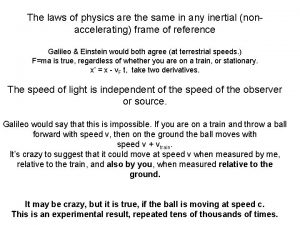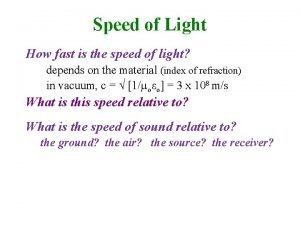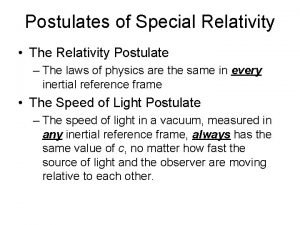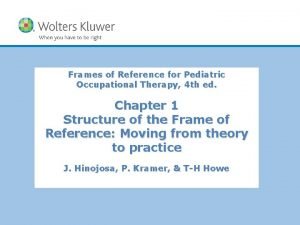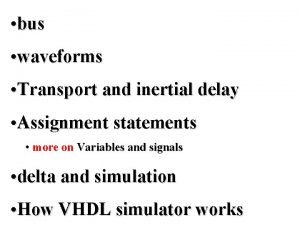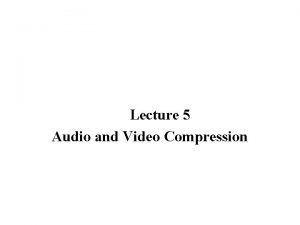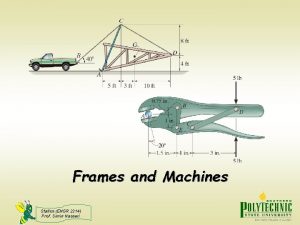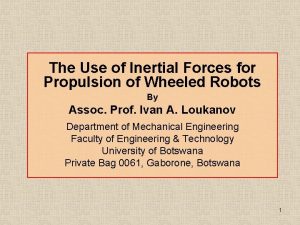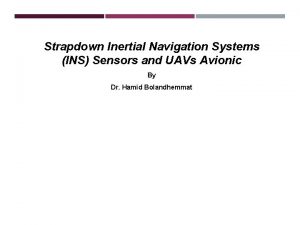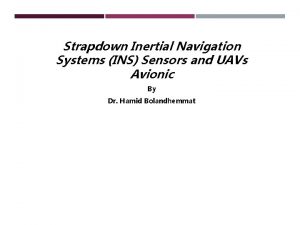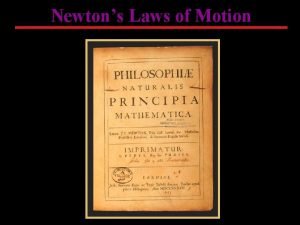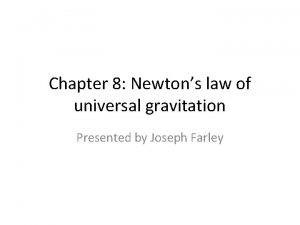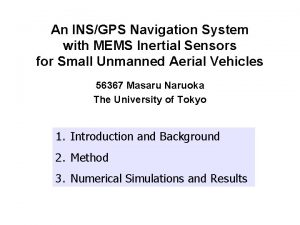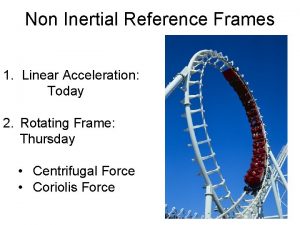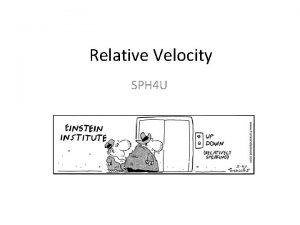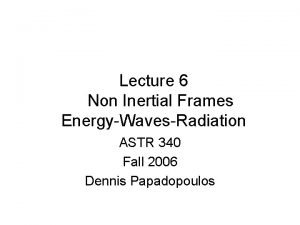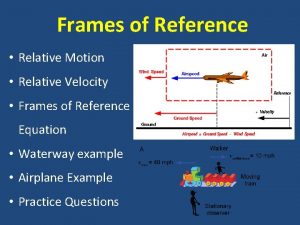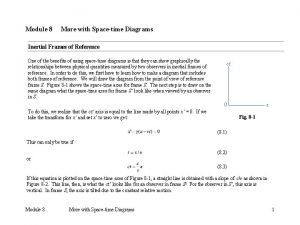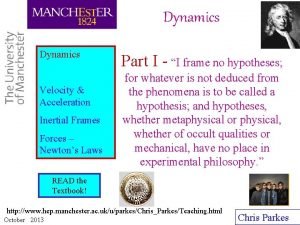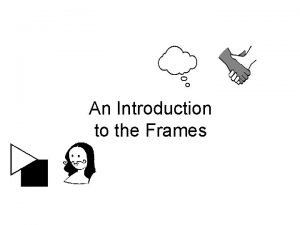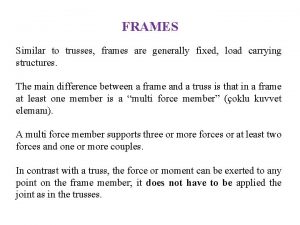Inertial and Non Inertial Frames of Reference Inertial



























- Slides: 27

Inertial and Non. Inertial Frames of Reference

Inertial and Non-Inertial Reference Frames n Recall: Newton’s first law of motion (law of inertia): An object at rest stays at rest and an object in motion stays in motion with the same speed and in the same direction unless acted upon by an unbalanced force.

Inertial and Non-Inertial Reference Frames n We’ve already talked about frames of reference in the Preliminary course when we talked about relative velocity. You know that a person sitting on a bus watching a ball roll across the ground will have a very different measurement of the ball’s velocity than a person standing outside the bus would measure the ball’s velocity.

That ball is moving at 5 km/h That ball is moving at 15 km/h Bus moves at 20 km/h

Inertial and Non-Inertial Reference Frames n The person inside the bus and the person outside the bus are measuring from different frames of reference.

Inertial and Non-Inertial Reference Frames n n Let’s change things a little… Imagine that you are travelling on the bus with a ball beside you sitting on the floor. The bus is moving forward at a constant velocity of 20 km/h. Bus moves at 20 km/h

Inertial and Non-Inertial Reference Frames n The ball on the floor does not move, which is as it should be because there is no net force acting on it and Newton’s first law says that it should stay resting unless acted on by some force. The ball is still. All is well. Bus moves at 20 km/h

Inertial and Non-Inertial Reference Frames n Suddenly, the bus starts to decelerate… Bus is slowing down

Inertial and Non-Inertial Reference Frames Suddenly, the bus starts to decelerate… … and The ball starts to accelerate toward the front of the bus. . . n Wait… what the… Bus is slowing down

Inertial and Non-Inertial Reference Frames n Since there is no net force acting on this ball (no one pushed it) what is going on? Does this violate Newton’s first law? The laws of physics are deteriorating! Bus is slowing down

Inertial and Non-Inertial Reference Frames n The laws of physics seem to momentarily break down for you sitting on the bus. In reality, what has happened is that your frame of reference has been compromised.

Inertial and Non-Inertial Reference Frames n An inertial frame of reference is a frame of reference in which the law of inertia and other physics laws are valid. Any frame moving at a constant velocity relative to another frame is also an inertial frame of reference.

Inertial and Non-Inertial Reference Frames n n When the breaks are applied to the bus, the bus undergoes a negative acceleration. At this moment, it becomes a non-inertial frame of reference. A non-inertial frame of reference is a reference frame in which the law of inertia does not hold.

Inertial and Non-Inertial Reference Frames n n n Although the ball accelerates toward the front of the bus, there is no net force causing the acceleration. But if you are sitting on the bus, you observe the ball accelerating forward. That would imply to you as you sit on the bus that there is a net force forward on the ball. The reason there appears to be a net force on the ball is that you are observing the motion of the ball in the non-inertial reference frame.

Inertial and Non-Inertial Reference Frames n n If you were observing the motion from the road (which is an inertial frame of reference) the ball just continues to move forward at the speed it was already going, and it’s motion is easily explained by the law of inertia. To an observer in the inertial frame of reference (the ground) the bus experiences a net force causing it to decelerate. The ball just continues it’s forward velocity with no net force.

Inertial and Non-Inertial Reference Frames n To explain the ball’s motion if you are sitting on the bus, you need to invent a force that acts on the ball toward the front of the bus. This is called the fictitious force. It is an invented force that we can use to explain the observed motion in the accelerated frame of reference.

Example 1 n You are on a train which is initially travelling at 12 m/s [E]. You gently place a tennis ball beside your seat. a) What happens to the tennis ball’s motion? b) Draw an FBD of the ball in the frame of reference of the ground outside the train, and the frame of reference of the train c) The train starts to accelerate east. Draw a new FBD of the ball in both frames of reference.

Example 1 n You are on a train which is initially travelling at 12 m/s [E]. You gently place a tennis ball beside your seat. n a) What happens to the tennis ball’s motion? b) Draw an FBD of the ball in the frame of reference of the ground outside the train, and the frame of reference of the train c) The train starts to accelerate east. Draw a new FBD of the ball in both frames of reference.

Example 2 n A rubber stopper of mass 25 g is suspended by string from the handrail of a subway car travelling directly westward. As the subway train nears a station, it begins to slow down, causing the stopper and string to hang at an angle of 13º from the vertical. a) What is the acceleration of the train? b) Determine the magnitude of the tension in the string.

Example 2 A rubber stopper of mass 25 g is suspended by string from the handrail of a subway car travelling directly westward. As the subway train nears a station, it begins to slow down, causing the stopper and string to hang at an angle of 13º from the vertical. a) What is the acceleration of the train? Thus, the acceleration of the train is 2. 3 m/s 2 [E]

Example 2 A rubber stopper of mass 25 g is suspended by string from the handrail of a subway car travelling directly westward. As the subway train nears a station, it begins to slow down, causing the stopper and string to hang at an angle of 13º from the vertical. b) Determine the magnitude of the tension in the string. Thus, the magnitude of the tension in the string is 0. 25 N.

What does this have to do with Roller coasters? n n n One of the things that makes roller coasters fun is the feeling of weightlessness you have when you are going down a big hill. That feeling of weightlessness occurs because your apparent weight as you are in free fall down the hill is zero. Apparent weight is the magnitude of the normal force acting on an object in a non-inertial frame of reference.

What does this have to do with Roller coasters? n n When we are standing up on level ground, we experience a normal force up. This is the force of the ground against our feet. If you stand on a bathroom scale, the normal force up is equal to your weight on the scale (mg)

What does this have to do with Roller coasters? n n If you were to put that scale in an elevator, which is accelerating downward, the normal force will decrease, and your weight reading on the scale will appear to be less. You haven’t actually lost any mass, but in the accelerated reference frame, the normal force decreases because you and the elevator are accelerating, and therefore your weight will read as less.


What does this have to do with Roller coasters? n n Your new weight in this accelerated, non-inertial reference frame is called the ‘apparent weight’. On a roller coaster, when you are in free fall down a large hill, the acceleration of the ride is equal to g (9. 81 m/s 2) and the normal force between you and your seat becomes zero. This makes your apparent weight zero as you go down the hill, and is the reason you feel ‘weightless’: you no longer have the normal force of the seat pressing up against you.

What does this have to do with Roller coasters?
 Inertial and non inertial frame of reference
Inertial and non inertial frame of reference Inertial and non inertial frame of reference
Inertial and non inertial frame of reference Reference node and non reference node
Reference node and non reference node Reference node and non reference node
Reference node and non reference node How fast is light
How fast is light Special relativity postulates
Special relativity postulates Pediatric occupational therapy frames of reference
Pediatric occupational therapy frames of reference Quand le ciel est bleu mon garçon
Quand le ciel est bleu mon garçon Inertial delay and transport delay
Inertial delay and transport delay Cookies frames and frame busting
Cookies frames and frame busting Frames in engineering mechanics
Frames in engineering mechanics Effect audio
Effect audio Depth and complexity frame
Depth and complexity frame Statics frames
Statics frames Frame semantics fillmore
Frame semantics fillmore Browser security model
Browser security model Bolman and deal 4 frames
Bolman and deal 4 frames Semantic nets and frames
Semantic nets and frames Wearable inertial sensors
Wearable inertial sensors Inertial propulsion
Inertial propulsion Strapdown inertial system
Strapdown inertial system Strapdown inertial navigation system
Strapdown inertial navigation system Inertial mass vs gravitational mass
Inertial mass vs gravitational mass Inertia xray
Inertia xray Gravitational mass vs inertial mass
Gravitational mass vs inertial mass Inertial impaction
Inertial impaction Inertial mass vs gravitational mass
Inertial mass vs gravitational mass Mems inertial navigation system
Mems inertial navigation system

